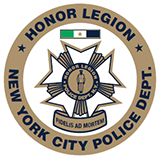History of the
Honor Legion

The Honor Legion was conceived and formed in January 1912 by Patrolman John W. Frazer who approached Chief Inspector (todays rank of Chief of Department) Maximillian F. Schmittberger with the idea. Chief Schmittberger approached Police Commissioner (PC) Rhinelander Waldo (1911-1913) who wholeheartedly endorsed and supported the proposal. The first meeting was held in the Trial Room of Police Headquarters at 100 Centre Street.
While serving as Chief Inspector, Schmittberger, Patrolmen John W. Frazer, and George Griffin, became the first Board of Directors of the Honor Legion. Chief Schmittberger served as the Chairman of the Board. John Jacob Astor was an Honorary Member and a faithful supporter, according to Chief Schmittberger. Astor, a friend of the Chief, perished on the Titanic. His son, William Vincent Astor, was voted by the membership of the Honor Legion to take his place. Membership in the Honor Legion required that the officer be an Honor Man, a sobriquet given to an officer who had previously been awarded a medal(s) typically on the occasion of the Annual Police Parade, which were held each spring. The group of such men were referred to as the Honor Men, and, when marching in a parade, the Honor Company.



Honor Men could be identified by the presence of at least one four-pointed star on the cuff of their uniform sleeve which represented a level of recognition, or award. These Representative Sleeve Stars were adopted on April 22, 1906 pursuant to General Order 40, signed by PC General Theodore Bingham (1906-1909), a Veteran of the Great War (World War I). The color of the four-pointed star signified the level of the award and deed, and were either gold, silver or bronze in color.
A gold star signified that the officer was awarded Honorable Mention with Medal for facing death and, against all odds, performing his duty to the standard of being faithful unto death. A silver star denoted an Honorable Mention with Certificate, awarded for a higher degree of bravery where the chances of losing life were about even. A bronze star reflected the fact that the officer received a Commendation for an act such as stopping a runaway horse, where the policeman takes the chance of being maimed, or even killed.
In December 1912, 400 of the 11,000 men in the department were members of the Honor Legion. Elaborate, large membership certificates (or diplomas), created in the style of those of the French Legion of Honor, were presented to members along with an emblem. The emblem was a medal-like adornment that may be pinned to their uniforms. (See image below.).
Of course, a plentiful sprinkling of scars, bullet marks and other evidence of flirtation with death go with the emblem and diploma, but that’s all in a days duty, said Honor Legion member, Sergeant (Sgt.) Daniel J.Fogarty. One of the most decorated officers in the history of the department, and a member of the Honor Legion, was Patrick Fitzgibbons, below.
Remarking on the type of police officer that comprised the membership of the Honor Legion, Sgt. Fogarty stated there were Not the kind of cops you read about in two inch letters across seven columns of the paper. There are cops who do creditable things in a quiet way. They have not the fire of patriotism to spur them on as does the soldier in battle. Their pay envelope will be no heavier at the end of the month for a hand to hand struggles with death. If they are maimed for life in the discharge of duty, they get honorable mention and a medal. They are men who keep faith with their work.
The first of many annual banquets was held on January 27, 1913.
In January 1914, the Honor Legion of the Police Department of the City of New York was incorporated with the Secretary of State of New York.

join the honor legion
mailing list
Sign up for our mailing list and get the latest and most up-to-date information on events, fundraisers and news that affects the law enforcement community.
